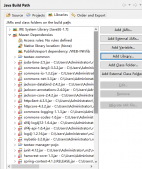前言
之前跟大家分享了Spring MVC集成springfox-swagger2构建restful API,简单写了如何在springmvc中集成swagger2。这边记录下在springboot中如何集成swagger2。其实使用基本相同。
方法如下:
首先还是引用相关jar包。我使用的maven,在pom.xml中引用相关依赖(原来我使用的是2.2.0的,现在使用2.4.0的):
|
1
2
3
4
5
6
7
8
9
10
|
<dependency> <groupId>io.springfox</groupId> <artifactId>springfox-swagger2</artifactId> <version>2.4.0</version></dependency><dependency> <groupId>io.springfox</groupId> <artifactId>springfox-swagger-ui</artifactId> <version>2.4.0</version></dependency> |
第二步就是创建swagger的配置类:
这个配置类和springmvc的写法完全一致。为了区分我又重命名一个。
|
1
2
3
4
5
6
7
8
9
10
11
12
13
14
15
16
17
18
19
20
21
22
23
24
25
26
27
28
29
30
31
32
33
34
35
36
37
38
39
|
package com.xingguo.springboot;import org.springframework.context.annotation.Bean;import org.springframework.context.annotation.Configuration;import springfox.documentation.builders.ApiInfoBuilder;import springfox.documentation.builders.PathSelectors;import springfox.documentation.builders.RequestHandlerSelectors;import springfox.documentation.service.ApiInfo;import springfox.documentation.service.Contact;import springfox.documentation.spi.DocumentationType;import springfox.documentation.spring.web.plugins.Docket;import springfox.documentation.swagger2.annotations.EnableSwagger2;@Configuration@EnableSwagger2public class Swagger2Configuration { @Bean public Docket buildDocket(){ return new Docket(DocumentationType.SWAGGER_2) .apiInfo(buildApiInf()) .select() .apis(RequestHandlerSelectors.basePackage("com.xingguo.springboot.controller")) .paths(PathSelectors.any()) .build(); } private ApiInfo buildApiInf(){ return new ApiInfoBuilder() .title("xingguo大标题") .description("springboot swagger2") .termsOfServiceUrl("http://blog.csdn.net/u014231523网址链接") .contact(new Contact("diaoxingguo", "http://blog.csdn.net/u014231523", "diaoxingguo@163.com")) .build(); }} |
在原来2.2.0的版本中使用new ApiInfo()的方法已经过时,使用new ApiInfoBuilder()进行构造,需要什么参数就添加什么参数。当然也可以什么都添加。如:
|
1
2
3
|
private ApiInfo buildApiInfo(){ return new ApiInfoBuilder().build();} |
那么页面显示的效果如图:
使用new ApiInfoBuilder().build();

添加属性:
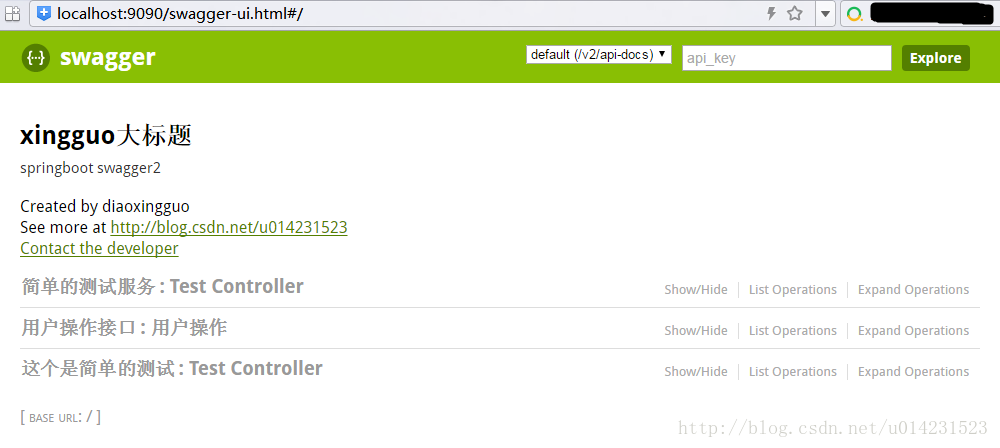
点击ApiInfoBuilder.Java的源码可以看到相关方法使用。
第三步就是在自己的controller添加相关的注解:
原来使用在类上使用@controller,现在可以使用@RestController,然后方法的@ResponseBody就可以不用写了,因为@RestController的注解接口上已经添加了,要求版本在4.0.1之后。
|
1
2
3
4
5
6
7
8
9
10
11
12
13
14
15
16
|
@Target(ElementType.TYPE)@Retention(RetentionPolicy.RUNTIME)@Documented@Controller@ResponseBodypublic @interface RestController { /** * The value may indicate a suggestion for a logical component name, * to be turned into a Spring bean in case of an autodetected component. * @return the suggested component name, if any * @since 4.0.1 */ String value() default "";} |
常用的注解如下:
- @Api()用于类名
- @ApiOperation()用于方法名
- @ApiParam()用于参数说明
- @ApiModel()用于实体类
- @ApiModelProperty用于实体类属性
更加详细的含义可以参考官方说明wiki
下面会用代码和示例图说明。
第四部就是在启动项目在浏览器上输入url:
http://{ip}:{port}/swagger-ui.html#/
我在application.properties中设置的自己的端口号为9090(如果不设置,默认为8080)
|
1
|
server.port=9090 |
所以我的url是:http://localhost:9090/swagger-ui.html
如图:
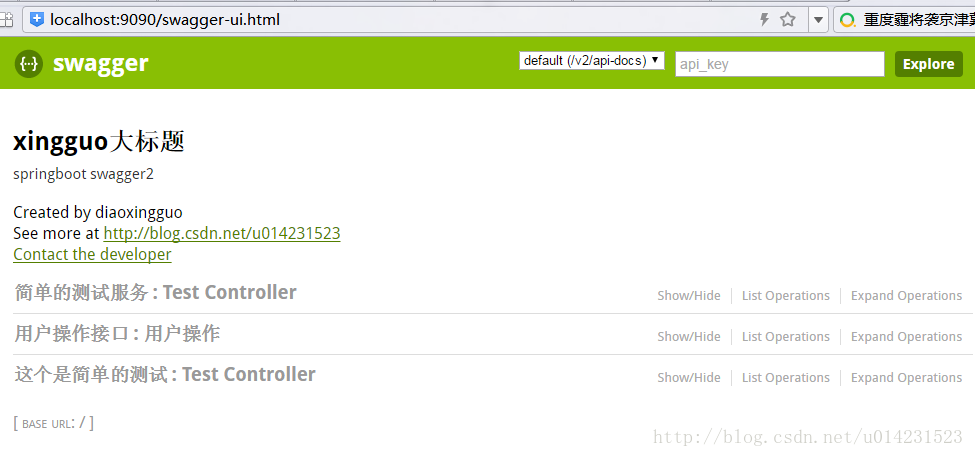
这里会把相应包下的所有controller按类进行显示。
我们看下其中一个类UserController.java,(请忽略业务逻辑,只看注解)
|
1
2
3
4
5
6
7
8
9
10
11
12
13
14
15
16
17
18
19
20
21
22
23
24
25
26
27
28
29
30
31
32
33
34
35
36
37
38
39
40
41
42
43
44
45
46
47
48
49
|
package com.xingguo.springboot.controller;import io.swagger.annotations.Api;import io.swagger.annotations.ApiOperation;import io.swagger.annotations.ApiParam;import javax.annotation.Resource;import org.springframework.web.bind.annotation.GetMapping;import org.springframework.web.bind.annotation.PostMapping;import org.springframework.web.bind.annotation.RequestBody;import org.springframework.web.bind.annotation.ResponseBody;import org.springframework.web.bind.annotation.RestController;import com.xingguo.springboot.model.User;import com.xingguo.springboot.service.UserService;/** * Created by diaoxingguo on 2016/10/24. */@Api(value="用户controller",description="用户操作",tags={"用户操作接口"})@RestControllerpublic class UserController { @Resource private UserService userService; @ApiOperation("获取用户信息") @GetMapping("/getUserInfo") public User getUserInfo(@ApiParam(name="id",value="用户id",required=true) Long id,@ApiParam(name="username",value="用户名") String username) { User user = userService.getUserInfo(); return user; } @ApiOperation("更改用户信息") @PostMapping("/updateUserInfo") public int updateUserInfo(@RequestBody @ApiParam(name="用户对象",value="传入json格式",required=true) User user){ int num = userService.updateUserInfo(user); return num; } @ApiOperation("添加用户信息") @PostMapping("/saveUser") public String saveUser(@RequestBody @ApiParam(name="user",value="json fromat",required=true) User user) { userService.saveUser(user); return "success"; }} |
这里说明下,在使用对象作为参数时,可以在对象上添加相应的注解,用户页面显示。
如:
|
1
2
3
4
5
6
7
8
9
10
11
12
13
14
15
16
17
18
19
20
21
22
23
24
25
26
27
28
29
30
31
32
33
34
35
36
37
38
39
40
41
42
43
44
45
46
47
48
49
50
51
52
53
54
55
56
57
58
59
60
61
62
63
64
65
66
67
68
69
70
71
72
73
74
75
76
77
78
79
80
81
|
package com.xingguo.springboot.model;import io.swagger.annotations.ApiModel;import io.swagger.annotations.ApiModelProperty;import java.util.List;/** * Created by diaoxingguo on 2016/10/24. */@ApiModel(description="用户对象user")public class User { @ApiModelProperty(value="用户名",name="username") private String username; @ApiModelProperty(value="状态",name="state",required=true) private Integer state; private String password; private String nickName; private Integer isDeleted; private String[] ids; private List<String> idList; public String getUsername() { return username; } public void setUsername(String username) { this.username = username; } public Integer getState() { return state; } public void setState(Integer state) { this.state = state; } public String getPassword() { return password; } public void setPassword(String password) { this.password = password; } public String[] getIds() { return ids; } public void setIds(String[] ids) { this.ids = ids; } public List<String> getIdList() { return idList; } public void setIdList(List<String> idList) { this.idList = idList; } public String getNickName() { return nickName; } public void setNickName(String nickName) { this.nickName = nickName; } public Integer getIsDeleted() { return isDeleted; } public void setIsDeleted(Integer isDeleted) { this.isDeleted = isDeleted; }} |
显示的效果如图:
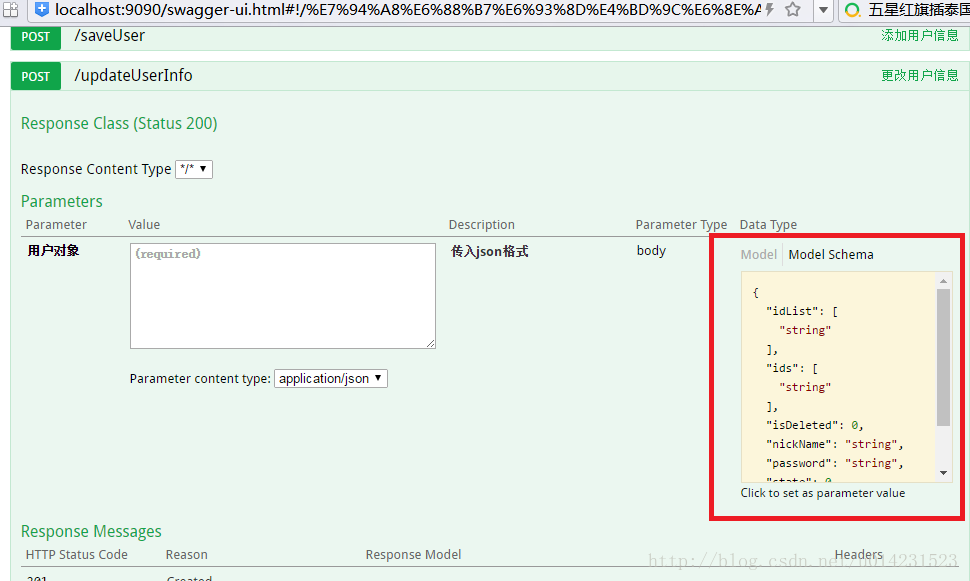
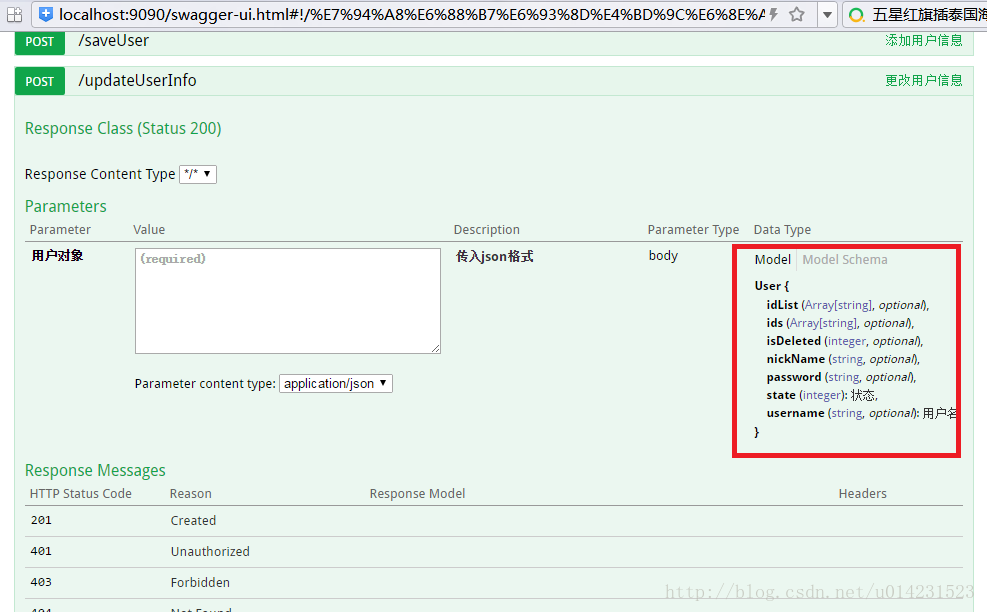
看上图红框的部分,其中一个是json格式的点击就可以获取参数格式。
第二张中可以看到字段相应的注释和是否必填。
如果在字段上添加注释@ApiModelProperty(required=true)就是必填(默认是false),相应的页面optional标识也会消失,标识这个字段必填。
点击下面的try it out按钮就可以进行调试。
在使用单个参数时,如上面代码中的getUserInfo()方法,对应的效果图如下:
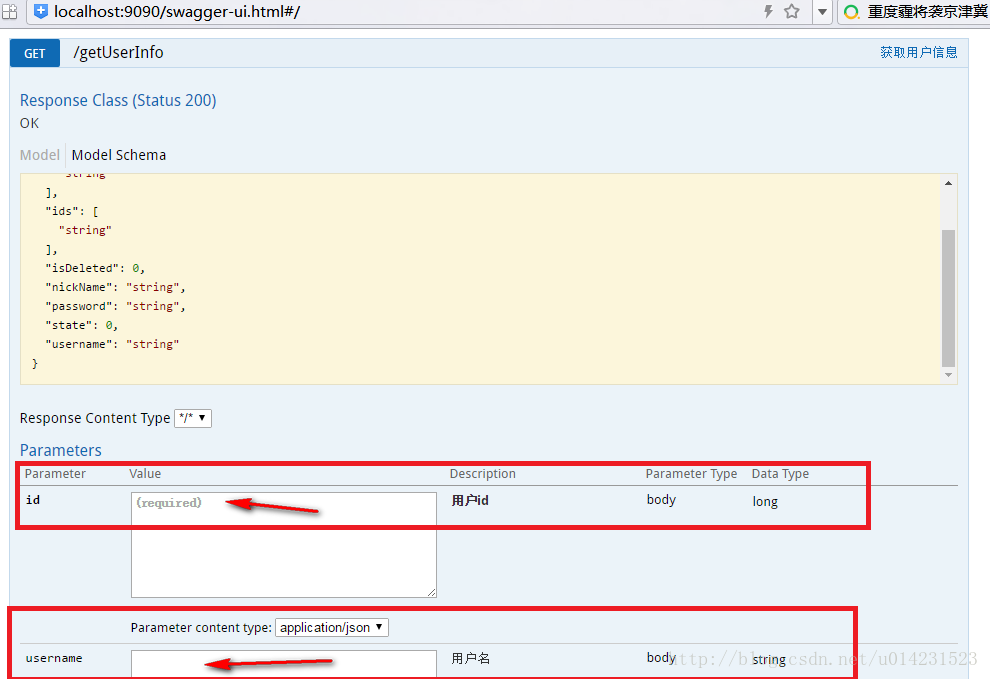
这里如果是添加required=true, @ApiParam(required=true)则会在页面上显示required的标识。同样默认为false。
其他的使用方式可以自己动手试试。
总结
以上就是这篇文章的全部内容了,希望本文的内容对大家的学习或者工作能带来一定的帮助,如有疑问大家可以留言交流,谢谢大家对服务器之家的支持。
原文链接:http://blog.csdn.net/u014231523/article/details/54562695


